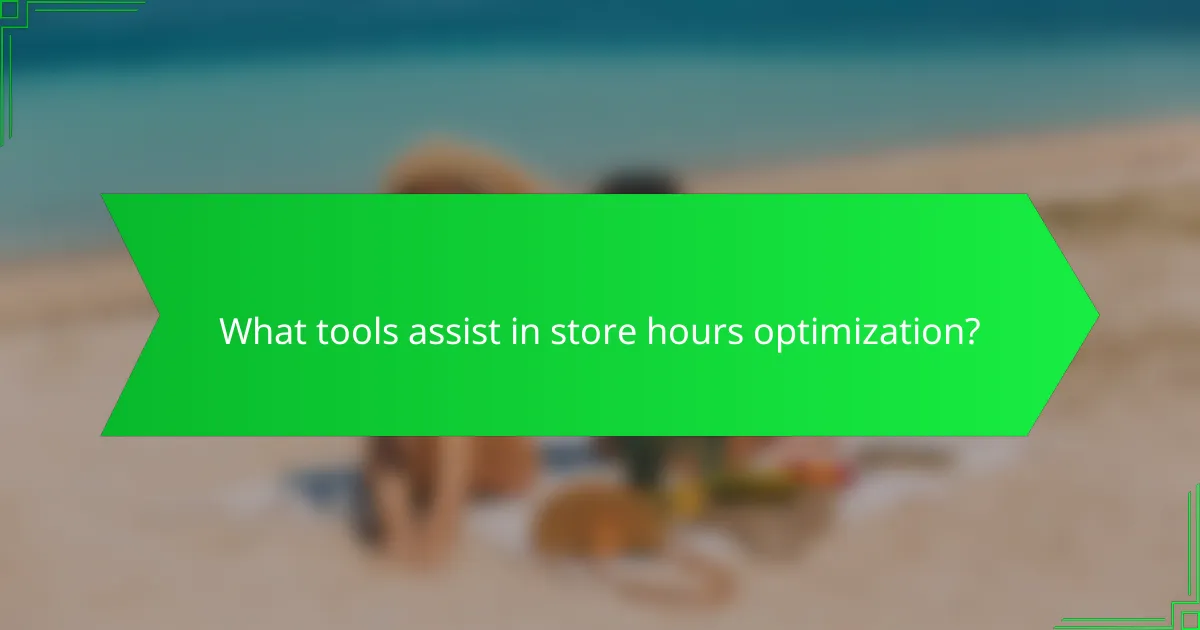Understanding optimal store hours is crucial for enhancing retail efficiency and maximizing sales. By leveraging data analytics, retailers can identify peak shopping times and adjust their hours accordingly, ensuring they meet customer demand while minimizing operational costs. Implementing effective optimization strategies not only improves resource allocation but also boosts customer satisfaction, ultimately leading to increased profitability.

What are the optimal store hours for e-commerce in the US?
The optimal store hours for e-commerce in the US typically align with peak shopping times, which can vary based on customer behavior and competitor practices. Generally, a 24/7 availability is ideal, but focusing on specific hours can enhance efficiency and customer satisfaction.
Peak shopping times
Peak shopping times for e-commerce usually occur during evenings and weekends, particularly from 5 PM to 10 PM on weekdays and throughout the day on weekends. These periods see increased traffic as customers are more likely to shop after work or during their leisure time.
During holidays and special sales events, such as Black Friday or Cyber Monday, peak hours can extend significantly, often starting earlier in the day. Retailers should prepare for spikes in traffic during these times to optimize their operations.
Customer behavior analysis
Understanding customer behavior is crucial for determining optimal store hours. Analyzing website traffic data can reveal when customers are most active, allowing businesses to adjust their staffing and marketing efforts accordingly. Tools like Google Analytics can provide insights into visitor patterns and peak times.
Additionally, surveys and feedback can help identify customer preferences regarding shopping hours. Engaging with customers through social media or email can yield valuable information about their shopping habits and expectations.
Competitor hour comparisons
Examining competitors’ store hours can provide insights into industry standards and customer expectations. Many successful e-commerce retailers operate 24/7, but some may focus on specific hours that align with their target audience’s shopping habits.
To gain a competitive edge, businesses should analyze competitors’ traffic patterns and promotional strategies during peak hours. This information can help inform decisions about when to run sales or promotions to maximize visibility and sales opportunities.

How can data analytics improve store hours?
Data analytics can significantly enhance store hours by identifying optimal times for operation based on customer behavior and sales patterns. By leveraging insights from various data sources, retailers can adjust their hours to maximize foot traffic and sales while minimizing costs.
Sales data insights
Analyzing sales data helps retailers understand peak purchasing times and seasonal trends. For instance, if data shows that sales spike on weekends or during holiday seasons, stores can extend hours during these periods to capture more revenue. Conversely, if certain weekdays show consistently low sales, reducing hours on those days can save operational costs.
Retailers should regularly review sales reports, ideally on a weekly or monthly basis, to identify these patterns. Utilizing software tools that visualize sales trends can make this process more efficient and actionable.
Traffic pattern analysis
Traffic pattern analysis involves studying customer footfall to determine when the store is busiest. Retailers can use foot traffic counters or mobile tracking data to gather insights on customer visits throughout the day. This information allows businesses to align their store hours with high-traffic periods, ensuring staff availability matches customer demand.
For example, if data reveals that customer visits peak between 5 PM and 7 PM on weekdays, extending hours to accommodate this influx can enhance customer satisfaction and increase sales. Regularly updating traffic analysis is crucial as patterns may shift due to seasonal changes or local events.
Customer feedback integration
Integrating customer feedback into store hour decisions can provide valuable insights into shopper preferences. Surveys, comment cards, and online reviews can reveal whether customers feel the current hours meet their needs. If many customers express a desire for earlier or later shopping options, adjusting hours accordingly can improve customer loyalty and satisfaction.
Retailers should actively solicit feedback and analyze it alongside sales and traffic data. This holistic approach ensures that decisions about store hours are data-driven and customer-focused, ultimately leading to better business outcomes.

What optimization strategies enhance retail efficiency?
Optimization strategies that enhance retail efficiency focus on improving operational processes, reducing costs, and maximizing customer satisfaction. Implementing these strategies can lead to better resource allocation, increased sales, and streamlined operations.
Dynamic scheduling
Dynamic scheduling involves adjusting store hours and employee shifts based on real-time data and customer traffic patterns. This approach allows retailers to align staffing levels with peak shopping times, ensuring adequate service without overstaffing during slower periods.
For example, a store might extend hours during holiday seasons or weekends when foot traffic is higher, while reducing hours on weekdays. Retailers should analyze historical sales data and customer flow to create effective schedules that respond to demand fluctuations.
Inventory management alignment
Aligning inventory management with store hours is crucial for maintaining stock levels that meet customer needs. Retailers should ensure that popular items are available during peak hours and adjust inventory levels based on sales trends and seasonal demands.
Utilizing inventory management systems can help track stock levels in real time, allowing for timely reordering and minimizing stockouts. Retailers should regularly review sales data to identify fast-moving products and adjust their inventory accordingly.
Staffing optimization
Staffing optimization focuses on ensuring that the right number of employees are scheduled at the right times to meet customer demand. This can involve analyzing sales data to predict busy periods and adjusting staff schedules to match those needs.
Retailers should consider factors such as employee skills and customer service requirements when optimizing staffing. Tools like workforce management software can aid in creating efficient schedules, reducing labor costs while maintaining service quality.

What tools assist in store hours optimization?
Several tools can significantly enhance store hours optimization by providing insights into customer behavior, sales patterns, and operational efficiency. Utilizing these analytics platforms helps retailers make informed decisions about when to open and close, ultimately improving profitability and customer satisfaction.
Google Analytics
Google Analytics is a powerful tool that tracks website traffic and user behavior, offering valuable insights into customer engagement. Retailers can analyze data related to peak shopping times, conversion rates, and user demographics to determine optimal store hours. By integrating Google Analytics with e-commerce platforms, businesses can align their physical store hours with online shopping trends.
To effectively use Google Analytics for store hours optimization, focus on metrics such as session duration and bounce rates during different times of the day. This data can guide adjustments to store hours, ensuring they align with customer demand.
Shopify Analytics
Shopify Analytics provides detailed reports on sales performance, customer behavior, and product trends for businesses using the Shopify platform. Retailers can leverage this data to identify peak sales periods and adjust their store hours accordingly. The platform’s built-in analytics tools allow for easy tracking of sales by time of day, helping to pinpoint when to maximize staffing and inventory.
When using Shopify Analytics, pay attention to the sales trends around holidays and special events. This can help retailers prepare for increased foot traffic and adjust store hours to meet customer needs effectively.
RetailNext
RetailNext specializes in in-store analytics, offering insights into customer traffic patterns, dwell times, and conversion rates. This tool helps retailers understand how store hours impact customer visits and sales, allowing for data-driven decisions on when to operate. RetailNext’s comprehensive dashboard provides real-time data, which can be crucial for making immediate adjustments to store hours.
To maximize the benefits of RetailNext, regularly review traffic data and correlate it with sales performance. This can reveal trends that inform whether to extend or reduce store hours based on actual customer behavior.

What are the impacts of store hours on customer satisfaction?
Store hours significantly influence customer satisfaction by determining when shoppers can access services and products. Extended hours often lead to higher satisfaction as they accommodate diverse schedules, while limited hours can frustrate potential customers.
Customer retention rates
Customer retention rates are closely linked to store hours, as flexible hours can encourage repeat visits. Retailers that offer extended hours may see retention rates improve by catering to customers who prefer shopping outside typical hours, such as evenings or weekends.
For example, a grocery store that remains open late may attract working professionals who find it challenging to shop during standard hours. This accessibility can foster loyalty, as customers appreciate the convenience and are more likely to return.
Shopping experience quality
The quality of the shopping experience is enhanced when store hours align with customer needs. Longer hours can reduce crowding during peak times, allowing for a more pleasant and efficient shopping environment.
Additionally, stores that are open during off-peak hours may provide better service, as staff can attend to customers without the pressure of long lines. This improved experience can lead to positive reviews and word-of-mouth referrals, further boosting customer satisfaction.

How do seasonal changes affect store hours?
Seasonal changes significantly impact store hours by influencing customer behavior and shopping patterns. Retailers often adjust their hours to align with increased demand during peak seasons, such as holidays, and to account for variations in foot traffic due to weather changes.
Holiday shopping trends
During the holiday season, stores typically extend their hours to accommodate increased customer traffic. Many retailers open earlier and close later, especially in the weeks leading up to major holidays like Christmas and Black Friday. This can mean operating hours that stretch from early morning until late at night.
For example, a store may shift from regular hours of 9 AM to 9 PM to a schedule of 8 AM to 11 PM. Retailers should analyze sales data from previous years to determine optimal hours that maximize foot traffic and sales during these peak times.
Weather impact on foot traffic
Weather conditions can greatly influence store hours by affecting customer willingness to visit. For instance, during inclement weather, such as heavy rain or snow, foot traffic may decrease, prompting retailers to consider reducing hours or closing early. Conversely, pleasant weather can lead to increased customer visits, justifying extended hours.
Retailers should monitor weather forecasts and historical data to adjust their hours accordingly. A practical approach is to track sales performance on days with varying weather conditions and adjust future hours based on this analysis. This can help optimize staffing and inventory management while ensuring customer satisfaction.

What are the future trends in store hours optimization?
Future trends in store hours optimization focus on leveraging data analytics and technology to enhance retail efficiency. Retailers are increasingly adopting flexible scheduling, integrating customer behavior insights, and utilizing automation to align store hours with demand patterns.
Data-driven decision making
Data-driven decision making is essential for optimizing store hours. Retailers can analyze foot traffic, sales data, and customer preferences to determine peak shopping times. By employing analytics tools, businesses can adjust their operating hours to better meet customer needs, potentially increasing sales and customer satisfaction.
For example, a store may find that customer visits peak during late afternoons on weekends. By extending hours during these times and reducing them during slower periods, retailers can maximize their operational efficiency.
Integration of technology
Integrating technology into store hours management is becoming increasingly important. Tools such as AI-driven scheduling software can predict customer traffic and suggest optimal hours based on historical data. This not only streamlines operations but also helps in staffing decisions, ensuring that the right number of employees are available when needed.
Additionally, mobile apps can provide customers with real-time updates on store hours and special promotions, enhancing their shopping experience and driving foot traffic during optimized hours.
Flexibility and adaptability
Flexibility and adaptability in store hours are crucial for responding to changing consumer behaviors. Retailers are moving towards more dynamic scheduling, allowing them to adjust hours based on real-time data and seasonal trends. This approach helps businesses remain competitive and responsive to market demands.
For instance, during holiday seasons, stores may extend hours to accommodate increased shopping activity, while reverting to standard hours during slower months. This adaptability can lead to improved customer loyalty and increased sales.
Focus on customer experience
Enhancing customer experience is a key trend in store hours optimization. Retailers are recognizing that convenience plays a significant role in customer satisfaction. By aligning store hours with customer preferences and shopping habits, businesses can create a more inviting shopping environment.
Offering extended hours on weekends or during special events can attract more customers. Additionally, providing options like curbside pickup during off-peak hours can cater to customers’ needs while optimizing store resources.
